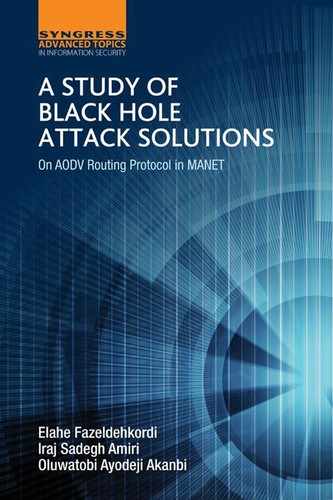List of Figures
| Figure 2.1 | Communications in wireless networks | 11 |
| Figure 2.2 | Infrastructure-based network | 12 |
| Figure 2.3 | Infrastructure-less network | 12 |
| Figure 2.4 | Simple ad hoc network | 13 |
| Figure 2.5 | MANET | 15 |
| Figure 2.6 | MANET | 16 |
| Figure 2.7 | MANET routing protocols | 24 |
| Figure 2.8 | Another classification of MANET routing protocols | 28 |
| Figure 2.9 | Flooding packets using MPR | 30 |
| Figure 2.10 | Hello message exchange | 30 |
| Figure 2.11 | AODV mechanisms | 32 |
| Figure 2.12 | Flooding RREQ in AODV | 32 |
| Figure 2.13 | Route reply in AODV | 33 |
| Figure 2.14 | AODV route discovery | 34 |
| Figure 2.15 | Route error message in AODV | 35 |
| Figure 2.16 | Classification of MANET attacks | 39 |
| Figure 2.17 | Active and passive attack in MANETs | 42 |
| Figure 2.18 | External and internal attacks in MANETs | 44 |
| Figure 2.19 | Different types of attacks on MANET | 45 |
| Figure 2.20 | Black hole problem | 46 |
| Figure 2.21 | Black hole attack specification | 48 |
| Figure 2.22 | Black hole attack | 49 |
| Figure 2.23 | Wormhole attack | 51 |
| Figure 3.1 | Research framework | 60 |
| Figure 3.2 | NS-2 schema | 63 |
| Figure 4.1 | “blackholeaodv” protocol agent is added in “ cllib s-lib.tcl” | 66 |
| Figure 4.2 | Addition to the “makefile” | 67 |
| Figure 4.3 | “If” statement for dropping or accepting the packets | 67 |
| Figure 4.4 | Case statements for choosing the AODV control message types | 68 |
| Figure 4.5 | False RREP message of black hole attack | 69 |
| Figure 4.6 | Data flow between node 0 and node 4 via node 1 with 6 mobility nodes | 70 |
| Figure 4.7 | Data flow between node 0 and node 4 via node 3 after mobility | 71 |
| Figure 4.8 | Data flow between node 0 and node 4 via nodes 13, 12, and 6 with 20 mobility nodes | 71 |
| Figure 4.9 | Data flow between node 0 and node 4 via nodes 8, 17, 11, and 2 after mobility | 72 |
| Figure 4.10 | Data flow between node 0 and node 4 via nodes 18, 2, and 12 with 30 mobility nodes | 72 |
| Figure 4.11 | Data flow between node 0 and node 4 via nodes 5, 28, and 10 after mobility | 73 |
| Figure 4.12 | The statements for creating mobile nodes | 74 |
| Figure 4.13 | Mobile node configurations | 75 |
| Figure 4.14 | Node 5 (black hole node) attracts the connection between nodes 0 and 3 | 75 |
| Figure 4.15 | Node 19 (black hole node) attracts the connection between nodes 0 and 4 | 76 |
| Figure 4.16 | Node 29 (black hole node) attracts the connection between nodes 0 and 4 | 76 |
| Figure 4.17 | Total drop packets comparison | 79 |
| Figure 4.18 | End-to-end delay comparison | 80 |
| Figure 4.19 | Routing overhead comparison | 81 |
| Figure 4.20 | Packet delivery ratio comparison | 82 |
| Figure 5.1 | RREP caching mechanism | 84 |
| Figure 5.2 | Receive RREP function of the IDSAODV | 85 |
| Figure 5.3 | CBR packet are reached to destination node properly | 86 |
| Figure 5.4 | Total drop packets comparison | 87 |
| Figure 5.5 | Total drop packets comparison | 88 |
| Figure 5.6 | End-to-end delay comparison | 89 |
| Figure 5.7 | End-to-end delay comparison | 90 |
| Figure 5.8 | Routing overhead comparison | 90 |
| Figure 5.9 | Routing overhead comparison | 91 |
| Figure 5.10 | Packet delivery ratio comparison | 92 |
| Figure 5.11 | Packet delivery ratio comparison | 93 |
..................Content has been hidden....................
You can't read the all page of ebook, please click here login for view all page.
